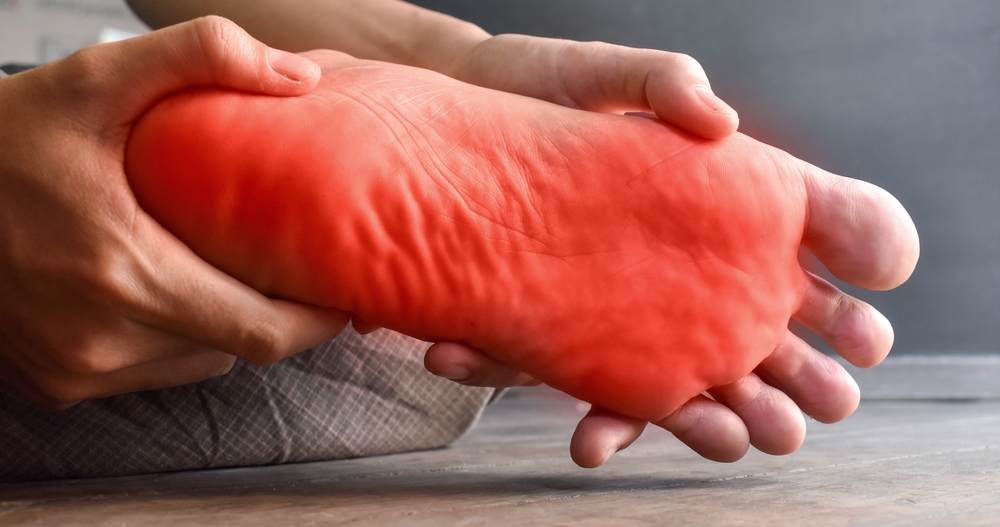Everyone deals with pain from time to time, whether you stubbed your toe on the coffee table or injured your elbow while playing tennis. When you are dealing with pain, you probably aren’t thinking about the specific kind of pain you’re experiencing. In fact, pain can keep you from thinking clearly, and you are likely looking for the best way to make the pain go away for good. You’re probably familiar with minor aches and pains versus chronic pain, but did you know even those can have different kinds of pain? When you go to the doctor because of pain, they will determine what type of pain you are dealing with, so they can ensure the best course of treatment for you. The two main types of physical pain include nociceptive and neuropathic pain. Here’s what you need to know about the differences between nociceptive pain and neuropathic pain, including their causes and treatment options.
What Is Nociceptive Pain?
 You might not have heard this word before, but nociceptive actually refers to the most common type of pain! Your body is filled with nociceptors which recognize this type of pain and send signals to your brain that something is happening. Nociceptors recognize potentially harmful stimuli, like things that could harm or damage your body. Any injury or damage to your muscles, bones, skin, or other tissues will have nociceptors sounding the alarm and result in nociceptive pain. Your brain gets the message from these nociceptors through nerves that make up your central and peripheral nervous systems. Once your brain gets the messages, you experience nociceptive pain, which can feel dull and aching, throbbing, or sharp and stabbing.
You might not have heard this word before, but nociceptive actually refers to the most common type of pain! Your body is filled with nociceptors which recognize this type of pain and send signals to your brain that something is happening. Nociceptors recognize potentially harmful stimuli, like things that could harm or damage your body. Any injury or damage to your muscles, bones, skin, or other tissues will have nociceptors sounding the alarm and result in nociceptive pain. Your brain gets the message from these nociceptors through nerves that make up your central and peripheral nervous systems. Once your brain gets the messages, you experience nociceptive pain, which can feel dull and aching, throbbing, or sharp and stabbing.
Causes of Nociceptive Pain
Both acute and overuse injuries can lead to nociceptive pain. Minor injuries like scrapes and bruises can cause nociceptive pain, like when a cut breaks the skin, or you bump your knee on a table and it starts to bruise. Extreme temperatures can also cause pain and discomfort, especially if you suffer a burn from something hot or hold your hand against something icy for too long. A broken bone, also known as a fracture, will also lead to a lot of pain and discomfort, especially at first. This is also a type of nociceptive pain. Joint pain, whether because of a sudden injury, overuse, or joint damage, is also a type of nociceptive pain. Arthritis is one of the most common causes of joint pain, especially in older aged adults. Wear and tear on the joints can cause the tissues that support the joint to break down and cause pain.
What Is Neuropathic Pain?
 Neuropathic pain refers to pain caused by damaged or aggravated nerves. Your central nervous system and peripheral nervous system send and receive signals from nerves all over the body. Nerves send these signals to your brain and back with so much information, like how and when to move and what type of sensations you experience. When one of these nerves becomes damaged or injured, it can disrupt these communication signals and lead to neuropathic pain. People who experience neuropathic pain typically describe it as a burning sensation or shooting pain that radiates into other parts of the body. Neuropathic pain may feel like a burning sensation underneath the skin and make the area sensitive to the touch. This type of pain can also send shooting pain into other parts of the body because that’s where the nerve would typically send a healthy message to. For example, the sciatic nerve controls your sensations and mobility in the lower half of your body. Damage or compression of this nerve can lead to sharp, stabbing pain that runs through your hip, buttock, leg, and into your foot.
Neuropathic pain refers to pain caused by damaged or aggravated nerves. Your central nervous system and peripheral nervous system send and receive signals from nerves all over the body. Nerves send these signals to your brain and back with so much information, like how and when to move and what type of sensations you experience. When one of these nerves becomes damaged or injured, it can disrupt these communication signals and lead to neuropathic pain. People who experience neuropathic pain typically describe it as a burning sensation or shooting pain that radiates into other parts of the body. Neuropathic pain may feel like a burning sensation underneath the skin and make the area sensitive to the touch. This type of pain can also send shooting pain into other parts of the body because that’s where the nerve would typically send a healthy message to. For example, the sciatic nerve controls your sensations and mobility in the lower half of your body. Damage or compression of this nerve can lead to sharp, stabbing pain that runs through your hip, buttock, leg, and into your foot.
Causes of Neuropathic Pain
Injuries and illnesses can lead to neuropathic pain, including shingles, diabetes, and cancer. Shingles is a viral infection that can cause a painful rash and affect your nerves. If you have ever had chicken pox, then you are at risk of getting shingles because the virus that causes both stays inside your body and can become reactivated. Unlike nociceptive pain because of a regular skin rash, shingles actually aggravates nerves below the skin and damages these nerve fibers, which can lead to chronic, neuropathic pain that lasts for days, weeks, or even months. Diabetes causes a specific type of neuropathic pain known as diabetic neuropathy because of how this disease can cause nerve damage, specifically in your hands and feet. Some injuries like carpal tunnel syndrome also cause neuropathic pain because inflammation in the wrist leads to compression of the median nerve in your wrist. The painful sensation after hitting the outside of your elbow against something, or “hitting your funny bone”, can also cause neuropathic pain because of aggravation to a nearby nerve.
How to Diagnose Nociceptive vs. Neuropathic Pain
In general, the difference between nociceptive versus neuropathic pain lies in what part of the body has suffered damage or injury. An issue with the body’s neurological system typically causes neuropathic pain, while an issue with the musculoskeletal system leads to nociceptive pain. When you experience nociceptive pain, this is typically an indicator that you have a physical issue or injury that may even be visible, like a broken bone or laceration. However, neuropathic pain only occurs internally, which means you are the only one who can locate the pain you feel without further testing. For example, dropping a bag of groceries on your foot may cause bruising, redness, and swelling, along with nociceptive pain. However, foot pain when your foot looks totally normal could be caused by neuropathic pain from a health condition like diabetes or nerve damage inside the body.
Treatment Options for Pain
When it comes to treating pain, you want to make sure to address pain at the source. While there are ways to temporarily relieve your discomfort, in order to experience lasting relief, you need to treat what is causing your pain. That’s why your treatment options will differ depending on what is causing your pain, along with the type and severity of your pain. Here are examples of treatment options for nociceptive vs. neuropathic pain relief.
Pain Management
Options for pain management include both short-term and long-term solutions. A short-term solution for pain may be to take over-the-counter medications like anti-inflammatory medication after an injury. This can help reduce any sudden swelling and inflammation while temporarily relieving your discomfort. Your doctor may write you a pain medication prescription for a short period of time to help with severe pain while you recover. However, pain medication only temporarily numbs your pain and does not treat it at the source. That’s why this type of pain management is typically only recommended when you are also engaged in other treatment options that will offer more lasting results.
Physical Therapy
Physical therapy can help with both nociceptive and neuropathic pain through a hands-on approach to pain relief. Your College Park physical therapist will walk you through stretches and exercises to help improve your strength and mobility after an injury. A physical therapist can also help you improve your range of motion and reduce pressure on nerves that may be causing you pain. Physical therapy allows you to take an active role in the treatment process, which can help boost your coordination, balance, and flexibility, too.
Chiropractic Care
A chiropractor can help address the source of your pain with this non-invasive and drug-free approach to pain relief and improved functioning. Chiropractors are known for treating back and neck issues with chiropractic adjustments to the spine, though they can also address a wide range of issues and injuries to your nerves, muscles, and other soft tissues. Misalignments in the spine and joints can put pressure on nearby nerves, causing neuropathic pain. You can also work with a chiropractor to recover from a car accident injury like whiplash or a sports injury like strained back muscles.
Surgical Procedures
In some cases, your doctor may recommend surgical intervention for long-lasting pain relief. Typically, surgery is only recommended after more non-invasive treatment options have failed to address your pain and discomfort. You may be a candidate for surgery depending on how intense your pain is, how long it has lasted, and what body structures are impacted by or causing your pain.
Visit AICA Orthopedics in College Park to learn more about how our pain specialists can help you. Our team of doctors includes chiropractors, physical therapists, neurologists, and orthopedic surgeons who treat all kinds of nociceptive and neurological pain. Our College Park doctors will get to the bottom of what’s causing your pain and develop a treatment plan specifically for you, your symptoms, and your goals. Whether you are dealing with arthritis, diabetes, or a car accident injury, our team of doctors is here to help. At AICA Orthopedics in College Park, we have X-rays, CT scans, and other diagnostic imaging tools available on-site so you can get a diagnosis and work on your treatment all in one convenient location.